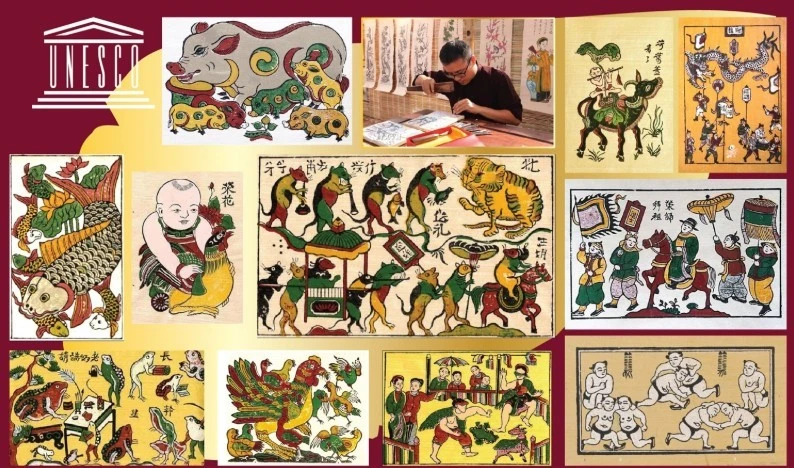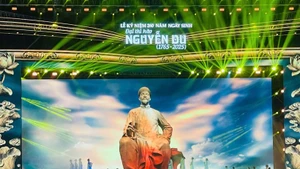The “Tu chien tren khong” (Death battle in the air) film acknowledges the effective collaboration between People’s Public Security Cinema and a private unit. (Photo: Film Crew)
Compared with the previous period, Vietnamese films were often overshadowed by imported foreign films, today the situation has changed dramatically thanks to the efforts, adaptability, and breakthroughs of filmmakers, the support of the state and private distributors, and the encouragement of audiences. The strong recovery of Vietnamese films not only reflects the creativity of filmmakers but also signals new prospects for cultural industry development.
A community is creative and upholds responsibility
The success of Vietnamese films in recent times is the result of collective efforts from the film crews, silent contributions of film distributors, and the sound policies of the Party and State.
A decisive factor has been filmmakers’ breakthrough and boldness in pushing creative boundaries, exploring new approaches, and making elaborate investments from script, settings to visual effects and soundtracks. This has breathed new life into national cinema
Films such as “Dao, Pho va Piano” (Dao, Pho and Piano), “Dat rung phuong Nam” (Southern Land), “Mai”, “Dia dao: Mat troi trong bong toi” (Tunnels: Sun in the Dark), and “Mua do” (Red Rain) are state-funded or privately produced films, all proving that Vietnamese cinema can conquer audiences both artistically and commercially.
Encouragingly, standout films have gone beyond pure entertainment, tackling major themes such as history, revolutionary wars, and national culture with fresh, modern presentations conveying deep messages.
At the same time, open policies of the state have encouraged greater private participation in film production, distribution, and exhibition. Previously, cinema systems mostly focused on imported foreign films to ensure box office returns. At present, major distributors such as CGV, BHD, Galaxy, and Lotte Cinema are paying more attention to domestic films.
Instead of passive film distribution, these units have accompanied film projects from the concept stage, contributing ideas to scripts, discussing promotional strategies, and even sharing financial risks with producers.
As a result, many Vietnamese films are released with well-planned communication campaigns and reasonable screening schedules, creating “box-office fevers”. Recently, “Tu chien tren khong” collected over 20 billion VND on its opening day, marking successful cooperation between People’s Public Security Cinema and Galaxy Group, a private entertainment corporation.
Director Bui Trung Hai expressed his optimism: “I believe that in the future, private investors will participate more actively in producing and distributing films about the Vietnamese revolutionary war, once they recognise the potential of this genre.”
Social resources may be promoted to turn the relationship between production and distribution into a virtuous cycle: strong distribution drives strong production, and vice versa, good production ensures favourable distribution. This crucial shift contributes to creating a “cinema ecosystem”, paving the way for Vietnamese films to develop dramatically.
In 2024, according to Box Office Viet Nam, total box office revenue reached nearly 4,700 billion VND, the highest figure in history so far, in which Vietnamese films contributed about 1,900 billion VND, accounting for 40%.
In 2025, the figure continues to grow dramatically. In just the first four months of 2025, revenue from Vietnamese films reached over 1,500 billion VND.
The blockbuster film “Mua do” alone earned around 680 billion VND in a month of release, making the cinematic landscape brighter this year.
Clearly, society’s entertainment demand is increasing, and if film projects are invested carefully, passionately, mobilising collective strength and promoted in the right way, Vietnamese films are fully capable of competing fairly with foreign films. Most importantly, the enthusiastic support of audiences for domestic films opens great potential for cinema in particular and cultural industry in general to break through.
Opening doors for further development
To help the Vietnamese cinematic ecosystem uphold its effectiveness, bottlenecks must be resolved, especially in distributing state-ordered films.
In recent years, many high-quality films have lacked suitable distribution mechanisms, leading to situations where they are screened only for reporting purposes before being shelved, wasting resources and missing opportunities to spread their value to the community.

Experience from films such as “Dao, Pho and Piano” and “Mua do” shows that when management agencies, producers, and distributors cooperate closely together, even state-funded films can achieve both artistic and commercial success.
Therefore, authorities need to quickly build flexible mechanisms and policies to encourage private distributors to engage deeply in distributing and releasing films, bringing works closer to the public, contributing to orienting aesthetic tastes and enriching the spiritual life of society.
Dang Tran Cuong, Head of the Department of Cinema, said that the decree on distributing and screening films serving political missions is being completed, creating a new, clear, and transparent legal framework with many regulations to enable state-ordered films to reach audiences more widely and effectively. Accordingly, mechanisms encouraging public–private cooperation and socialisation of film distribution will be strengthened.
In addition, for a sustainable cinema ecosystem, it is necessary to pay more attention to cinemas. Digital technology and online platforms are opening new distribution channels, giving opportunities for Vietnamese films to access broader audiences.
Many films continue their commercial life after cinema runs end by being released on digital platforms, extending revenues and increasing international reach. This is an unavoidable trend that requires supportive policies from managers, producers, and distributors, as well as protection of copyright and intellectual property rights in the digital environment.
Resolution No. 33-NQ/TW issued in 2014 highlighted the mission of developing Vietnamese culture and people in the context of integration, to meet the country’s sustainable development goals. In the Cultural Development Strategy to 2030, the Government has identified cinema as one of the spearhead sectors of the cultural industry. The Law on Cinematography (2022) stipulates that the state has policies to mobilise resources, carry out measures to ensure a healthy investment and business environment, and develop the cinema market, creating favourable conditions for organisations and individuals to participate in cinema activities to build a cinema industry associated with socio-economic development and international integration.
These are key foundations showing that building a cinematic ecosystem is not only the responsibility of filmmakers and distributors, but also requires the coordinated involvement of the state, businesses, and society.
In this ecosystem, audiences continue to play a central role because they are the ultimate measure of a film’s success and the driving force for film producers and distributors to invest more in Vietnamese films.
When audience trust is strengthened, the market will become a solid foundation for Vietnamese cinema to rise and affirm its position in the country and the world. Supporting Vietnamese films and nurturing a national cinematic ecosystem must be seen as a cultural mission linked to social responsibility.
This will help form habits of film enjoyment as well as inspire love for cinema, nurture the national cultural identity in the Vietnamese mind, and help Viet Nam’s image shine more brightly on the world cultural map.
















